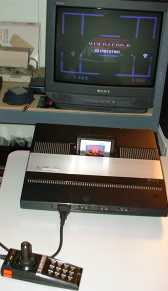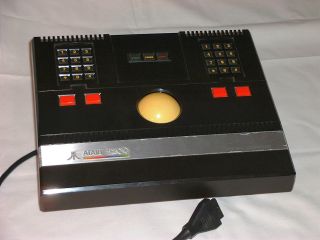The Atari 5200 SuperSystem, released in the US in
late 1982, was the direct follow-up to the highly
successful Atari 2600 (VCS), and predecessor of the
Atari 7800 ProSystem. Atari chose to design the 5200
around technology used in their popular Atari 400/800
8-bit computer line, but was not directly compatible,
unlike Atari's much later pastel-colored XEGS (XE
Game System) console. The similarities in hardware
did allow for relatively easy game conversions between
the two systems, however, particularly when porting
from the computer line to the 5200.
The
Atari 5200, as designed, was more powerful than Mattel's
Intellivision and roughly equivalent to Coleco's ColecoVision,
both of which were the 2600's main competition at
the time and the systems Atari had to target in order
to remain technologically competitive in the console
marketplace. Besides the unusually large size of the
5200 console, the controversial automatic RF switch
box (incompatible with many televisions of the day
without the included adapter) that also supplied power
to the system and the innovation of four controller
ports (the Atari 800 computer also featured four controller
ports), the most notable feature of the system was
the inclusion of analog joysticks, which to the frustration
of most gamers were fragile and did not self center
(or as "The Game Doctor", Bill Kunkel, put
it, "dead fish floppo"), but had a keypad
that accepted overlays and featured one of the first
pause buttons. Part of the 5200's girth accommodated
storage for these controllers to the rear of the console,
as well as a wire wrap underneath.

Atari
5200
Alienating
a significant number of Atari 2600 users, the Atari
5200 was not backwards compatible with the popular
system, requiring the purchase of all new software.
With a lackluster initial game line-up, featuring
cartridges with versions of software like "Pac-Man",
"Space Invaders" and "Breakout"
that were already available on other systems, there
was little incentive for many consumers to not consider
the competition when upgrading consoles. With the
poorly designed controllers, the few games that were
otherwise impressive technically were difficult to
control. For games actually designed around the non-centering
analog joysticks, like Atari's own "Countermeasure"
or "Space Dungeon", the system fared much
better, but unfortunately these types of games were
few and far between.
Realizing
some of their mistakes, Atari released a smaller,
two controller port Atari 5200 with a standard television
switch box and independent power supply. In addition,
the company released an Atari 2600 cartridge adapter
to directly address an advantage that Mattel and Coleco
had for their systems. Unfortunately, this add-on
did not work with most of the 4-port 5200 models without
significant modifications to the consoles themselves.
Despite
all of these set-backs, the Atari 5200 had a slow,
but steady user growth cycle. Other hardware, like
the trak-ball, was well designed and received good
overall software support. The joystick holders that
came with certain games, like "Robotron: 2084",
were appreciated by hardcore gamers for allowing arcade
authentic simultaneous use of two joysticks. Third
party software support was fairly limited, but there
were many games in development right up to early 1984.
Unfortunately, by 1984, the console game market as
a whole was mired in the throes of the infamous videogame
crash, which left no mainstream console survivors
or software support.

Atari 5200 Trak-Ball
After
the Nintendo Entertainment System (NES) revived the
console industry beginning in late 1985, in 1986,
Atari chose to re-release a smaller Atari 2600 system
and resurrect the fully 2600 compatible Atari 7800,
which was in development in the latter stages of the
Atari 5200's short life cycle. While slightly more
advanced than the Atari 5200 in the areas of graphics
and overall system capabilities, it was a more traditional
design and featured an inferior sound processor. In
late 1987, Atari released the Atari XEGS, (named after
Atari's then current XE 8-bit computer line, the successors
to the popular XL series, which superseded the original
400/800 systems) a console-centric Atari 8-bit computer,
attempting to fulfill the 5200's unrealized potential
years too late.
Today,
there is a thriving Atari 5200 hobbyist community,
second only to the Atari 2600's, still creating new
games. Because of the 5200's relatively swift demise,
there are also an unusually high number of prototypes,
many of which have been made available. For the modern
collector, the hardware units themselves are relatively
easy to find, but the fragile controllers in good
working order are not. Further complicating matters,
the cheap controller contacts require regular cleaning,
as they corrode whether the joysticks are used a lot
or simply put in storage and not used at all. The
usual fix is to open the controllers and clean the
contacts with a pencil eraser, removing what looks
like black dirt (the corrosion). Obviously, this type
of cleaning can only be done a finite number of times
before certain controller elements completely wear
out or fail from the repeated maintenance. There were
rumors that if the videogame crash hadn't taken place
when it did, Atari was going to release a new generation
of self-centering 5200 controllers. Instead, third
party joystick solutions, including "y"
adapters for regular Atari joysticks, as well as the
first party trak-ball unit, were released, but are
now difficult to locate. Repair kits, refurbished
joysticks and adapters for other controller types
are readily available, but tend to be a hassle for
those without a serious dedication to the system.
What
one is left with when examining the life of the Atari
5200 SuperSystem, is a look at a relatively powerful
game console with an interesting, if somewhat small
software library, and one of the overall worst default
mainstream controllers in the history of electronic
gaming, from a company that should have known better.
The
aforementioned Atari 7800 ProSystem was originally
scheduled for launch in late 1984 as the follow-up
to the misguided 5200, but didn't see a full release
until 1986 in the US. Instead of competing with comparatively
weaker systems like the 5200 and ColecoVision, the
later release date for the 7800 brought direct competition
from the more robust NES, released in late 1985, and
the Sega Master System (SMS), which, like the ProSystem,
was released in 1986.
In
late 1984, despite having had successful showings
at trade events, an extensive and enthusiastic preview
in one of the top video and computer game magazines
of the day (Electronic Games), retail orders already
taken, and warehouses full of stock, Atari management
decided to shelve the system and its launch games
in favor of their computer line when it became apparent
to them - and seemingly everyone else in the industry
- that the videogame depression had become an irreversible
crash. Also put on the shelf was a redesigned 2600,
dubbed the Atari 2600jr due to its diminutive size.
These moves have often been criticized in hindsight,
but for those around at the time, it was clear that
videogames were being supplanted by low cost and powerful
personal computers as the more flexible game machines
of choice, and a game system in the traditional sense
simply wouldn't be financially sustainable.
All
this changed in 1985, however, when Nintendo test
marketed their successful Japanese game system in
America, the Famicom (short for Family Computer),
as the redesigned NES. Interestingly, Nintendo originally
approached Atari in early 1984 about marketing and
distributing the Famicom in America, but many factors,
including management changes and the rapid decline
of the videogame industry, led Atari to pass on the
opportunity and force Nintendo to partner with Worlds
of Wonder (the makers of "Teddy Ruxpin"
and "Laser Tag"), and eventually go it alone.
With a full product roll-out and clever marketing,
by 1986, Nintendo caught the buying public's fancy
and rejuvenated the videogame market. Atari, and soon
Sega, took notice of Nintendo's success and quickly
released systems of their own to try and capitalize
on Nintendo's momentum.

Atari 7800
Atari,
with no real interest or time to develop new technology,
decided to take the Atari 7800 and its existing warehoused
software and release the system as-is. Unlike the
NES, which was seemingly full of new ideas, the 7800's
deployment strategy was straight out of 1984, as were
the initial games. The cartridge included with the
7800 system, Pole Position II, looked primitive and
simple in comparison to one of the NES' included titles,
the now legendary Super Mario Bros. Surprisingly,
around the same time, Atari also released the 2600jr
for $50 (USA), supposedly as the system for gamers
on a budget, despite the fact that the 7800 was fully
backwards compatible, with the ability to utilize
nearly all existing 2600 software and peripherals.
Finally, there were even a few releases of remaining
stocks of 5200 software, including titles that didn't
make it out during the system's short prime, like
"Gremlins".
With
lack of an innovative initial line-up of games, retailer
indifference, absence of any real third-party software
support due to Nintendo's infamous contracts, and
lackluster marketing, the 7800, despite eventually
selling a few million systems, never really caught
on. To further add confusion to Atari's renewed videogame
initiatives, a third system (not counting the abandoned
5200), the XEGS, a console-centric Atari 8-bit computer,
was released in late 1987, complete with keyboard
and an Atari 2600/7800 compatible light gun, bringing
the company full circle to their original vision with
the failed 5200, but further removing company and
development resources from the 7800.
As described earlier, the Atari 7800 came bundled
with a Pole Position II cartridge and one controller-a
digital joystick with two side buttons similar in
shape to the Atari 5200's analog controllers, but
having no keypad. Atari kept the design simple, which
had worked well for the Atari 2600's controllers,
but the build quality was not as high, and some found
it uncomfortable. The 7800's single joystick controller
contrasted sharply with the then revolutionary NES
and SMS gamepad designs, but, for the European release
of the ProSystem, Atari instead packaged two of their
own interpretations of a gamepad in with the system,
as well as built "Asteroids" directly into
the console's memory. Unfortunately, the original
configuration in North America remained the same in
that region throughout the rest of the system's production
cycle. In fact, the NES, and eventually the SMS, were
available in various interesting boxed configurations,
including those with light guns and various other
peripherals, while Atari never came out with anything
comparable for the 7800, eventually only going as
far as releasing a few compatible games for use with
the XEGS light gun. Ironically, Atari had plenty of
exciting peripherals either developed or in development,
such as a keyboard add-on and high score cartridge,
but Atari's management decided each time to pass on
a release.
As
mentioned earlier, one of the major criticisms - perhaps
unfairly - of Atari's 5200 when first released, was
that it wasn't backwards compatible with the most
popular system of the day, their own 2600. Atari rectified
this situation by designing the Atari 7800 from a
base of 2600 technology, providing almost perfect
backwards compatibility, with the few inconsistencies
due to several minor 7800 production revisions over
the years. A type of encryption key was used to determine
whether software should run in the system's 7800 or
2600 modes, and also acted as a way to ensure only
authorized software ran on the system, something not
possible on prior Atari consoles. While Atari, unfortunately,
did not update the 7800's base sound capabilities
beyond the 2600's level, there was an ability to add
a custom sound chip - the Atari 5200's excellent "POKEY"
- internally to a cartridge to enhance audio, usable
either by itself or in conjunction with the built-in
sound processor. Atari did update the graphics and
other functions internally within the 7800 via several
new chips, the most important of which was the "MARIA",
which could allow over 100 objects on-screen at one
time and provided for very stable, flicker-free images,
particularly in comparison to the competition.
Much
the same as Atari's management refused to release
any peripherals for the 7800, and split already limited
company resources across two other consoles and several
different computers, an executive decision was made
to keep cartridge RAM (memory) sizes small to minimize
costs. Unfortunately, this in turn limited how advanced
games could become, creating unfavorable comparisons
to both NES and SMS software, which were under no
such restrictions. Worse, there were even rumors that
Atari purposely downgraded certain Atari 7800 titles
so as not to outshine their own XEGS. In spite of
this, a few games did eventually get released that
demonstrated the ProSystem's potential and created
more favorable comparisons, albeit too late to make
a difference in the hotly contested marketplace of
the mid- to late-1980's. As for the 7800's outdated
internal sound technology, only two games implemented
the POKEY chip option, creating too few examples of
the system's extended audio capabilities. In short,
these limited uses of the system's power, combined
with the fact that many Atari 2600 games were also
labeled for use on the 7800, gave many the false impression
that the system wasn't competitive.
The
7800 ProSystem's history, like many Atari consoles,
is that of a system whose full potential was never
realized. Atari's management was responsible for many
of the system's implementation blunders, but ultimately,
the 7800 was a victim of bad timing, first with the
1984 videogame crash, and second going up against
Nintendo and their eventual greater than 90% share
of the videogame market, and all the industry influence
that entails.
While
it will probably never have the sizable hobbyist communities
of the 2600 or 5200, there nevertheless is a growing
movement for new developments, which bodes well for
collectors, as the system and a lot of its software
is still fairly easy to locate on the used market.
Despite some difficulty in finding original working
two-button controllers, unlike the 5200, there are
readily available third-party solutions, and many
of the games use standard single-button 2600-style
controllers anyway. This type of controller is always
easy to find, and even most SMS and Sega Genesis/Megadrive
controllers work for all single button games without
modification.
by
Bill Loguidice

A
small selection of Atari controllers through the years.
From left to right: Atari 2600 VCS pack-in joystick,
Atari 2600 VCS paddle controller (1 of 2), Atari 2600
VCS keyboard controller (usually 2), Atari 2600 VCS
racing controller (essentially a paddle controller
that spins freely), Atari trak-ball controller (compatible
with all Atari systems up to Jaguar), Atari 2600 VCS
video touch pad, Atari 5200 pack-in controller, Atari
7800 US pack-in controller, Atari XEGS pack-in controller
(same as 2600 pack-in except different color) and
Atari Jaguar joypad. For a company that got so much
right with their first Atari 2600 VCS pack-in joysticks
and did so well designing alternative controllers,
the pack-in controllers for the Atari 5200, 7800 and
Jaguar were particularly disappointing for many game
players.
This
article originally appeared in the premiere online
edition of Armchair Arcade.
If you would like to read similar articles, be sure
to check them out!

